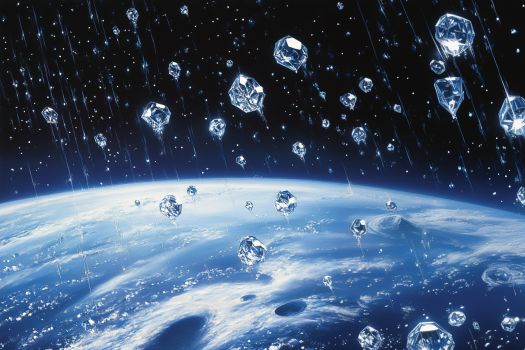
Imagine a place where it rains diamonds; not water, not snow, actual diamonds falling from the sky!
It sounds like a fantasy story, but scientists believe this happens on planets like Neptune and Uranus. These two gas giants are located far away in our solar system, and their extreme weather conditions make it possible for diamonds to form in their atmosphere and fall like rain deep inside the planets.
Amazing right?
But how does this happen? Scientists think that the incredible pressure and heat inside these planets turn carbon, (an element found in everyday things like coal and pencil lead) into sparkling diamonds. The deeper you go inside these planets, the more intense the pressure becomes, making the diamonds even bigger.
The science behind diamond rain
Neptune and Uranus are made mostly of hydrogen, helium, and methane. Methane, the gas that gives these planets their bluish colour, plays a key role in creating diamond rain.
When storms occur deep inside these planets, the heat and pressure break apart methane molecules, releasing carbon atoms.
These free carbon atoms then stick together, forming tiny pieces of diamonds. As they move further into the planets, they grow larger due to the increasing pressure. Eventually, these diamonds fall like raindrops, sinking deep into the planet's core. Some scientists even believe these diamonds could form large, solid diamond layers deep within Neptune and Uranus.
ALSO READ: The Reason Why People Believe the Earth is Flat
Can we ever collect these diamonds?
Unfortunately not. It sounds tempting to want to travel to Neptune or Uranus and collect these space diamonds, but it’s nearly impossible. These planets are over 2.5 billion kilometers away from Earth. Even if we could reach them, their extreme temperatures, high pressure, and violent storms would make it impossible for humans or machines to survive.
Scientists, however, are hopeful that future space missions might study these planets in more detail.
Why is this discovery important?
The idea of diamond rain is exciting, but it also helps scientists understand the chemistry of planets. If diamonds can form naturally on Neptune and Uranus, similar processes might be happening on exoplanets, planets outside our solar system. This could change what we know about how planets develop and whether they could support life.
Additionally, studying these extreme conditions helps scientists design better technology for space exploration. The materials that survive high pressure on Neptune could inspire new ways to build stronger equipment for deep-sea or space travel.
ALSO READ: 5 amazing earth events that science can't fully explain